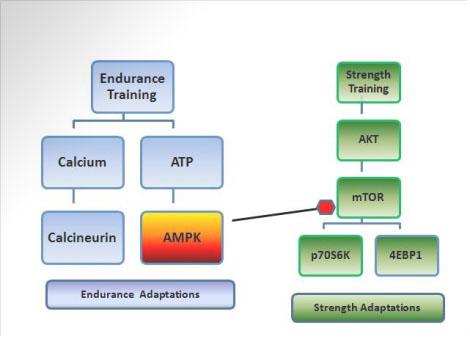Endurance training (or cardio) remodels your body to be more energy efficient (or fuel efficient) - it is akin to a super car which gets better and better mileage, the more and the more you drive. On the on the other hand, strength training makes you faster, stronger and bigger but lowers energy efficiency (fuel efficiency).
What is the Problem?Besides a few studies, most have shown strength adaptations to suffer when endurance training (cardio) is combined with strength training There has been a few mechanisms proposed to explain this limit set by endurance exercise on strength gains.
- Concurrent endurance and strength training can increase the workload and make you overtrained, and cut into strength adaptation.
- Another mechanism is endurance training can convert fast fibers into slow fibers and reduce the number of fast fibers, which could play a major role in limiting strength and muscle development.
- Glycogen depletion has been proposed as another mechanism behind this phenomenon.
Now that I have introduced the concept and mechanisms, let’s go back to the question of whether cardio should be done on lifting on non-lifting days. The mechanisms above do not really help in answering our question because they are chronic adaptations and their influence doesn’t change with changing the days you do cardio. So the question remains - but not for too long: What is the Solution?ATP is the energy currency of a cell: Just how money is vital for us, so is ATP for a cell. We keep track of our money, but who keeps track of the ATP in the cell? This highly important job is done by an enzyme called AMPK, and it is rightly termed as the ‘energy sensor’ of the cell.
The good news is that AMPK is always activated with endurance exercise (bcos of the high energy or ATP needs for endurance exercise) and most endurance adaptations are purported to signal through AMPK. The bad news is that once AMPK is activated it shuts of anabolic events, like protein synthesis to prevent further loss of energy or ATP.
AMPK activation has shown in both animal and human studies (not yet conclusive in humans) to play a causal role in reducing protein synthesis. The blunting of protein synthesis during resistance exercise and after endurance exercise is now shown to be partly due to AMPK activation.
 Figure1: Molecular representation of how cardio blunts strength training adaptations via AMPK Figure1: Molecular representation of how cardio blunts strength training adaptations via AMPK If this—AMPK due to cardio blunts protein synthesis—makes any sense, doesn’t it make sense to keep your cardio and strength training as far apart as possible? This would make a lot of sense sense if AMPK is activated and only stayed elevated for a few hours. Fortunately for us, AMPK in human studies has shown to have a short life, and tends to return back to basal levels after 1-3 hours of endurance exercise.
ConclusionIn short , AMPK blunts protein synthesis and cardio increases AMPK. So keep your cardio and weight workout far apart, like on seperate days or morning/evening.
Note: AMPk activation in muscle is localized as shown by one-legged training studies. So it might be better to keep your cardio adjacent to upper body lifting days. As well, have your high-intensity cardio days and strength workouts far apart since AMPk activation is time and intensity dependent. Again, having a pre-workout shake becomes all the more important considering that extra cellular events, such as glycogen, glucose, and creatine phosphate availability, besides ATP depletion, can negatively influence AMPK activation,
For endurance weenies trying to increase endurance adaptations, the approach of having carbs before and after endurance sessions may not be a good idea because they are inhibiting the activation and activity of AMPK, which plays a major role in endurance training adaptations.
*AMPK: AMP- activated Protein Kinase
*ATP: Adenosine Triphoshphate
 该贴已经同步到 jacky的微博 该贴已经同步到 jacky的微博 |  |小黑屋|手机版Mobile|体能论坛
( 粤ICP备15092216号-2 )
|小黑屋|手机版Mobile|体能论坛
( 粤ICP备15092216号-2 )